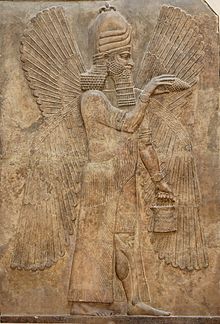In Near Eastern Culture the Winged Genius Often Represented in Art and Artifacts Was a

Winged genie, c. 870 BC, with inscription running across his midriff.

Winged genie is the conventional term for a recurring motif in the iconography of Assyrian sculpture. Winged genies are unremarkably bearded male figures sporting birds' wings. The Genii are a reappearing trait in ancient Assyrian fine art, and are displayed about prominently in palaces or places of royalty. The two most notable places where the genies existed were Ashurnasirpal II'due south palace Kalhu and Sargon II'south palace Dur-Sharrukin.
Variations of style [edit]
They announced in the reliefs of the walls and throughout the temples and palaces in a wide multifariousness of ways. At that place are three common stylistic tendencies in reliefs with genii. First at that place are disguised, winged figures wearing a horned helmet. Next there are disguised, winged figures wearing a diadem instead of helmet. Finally there are winged, muscular, male person figures with bird heads. They are commonly adorned with rosettes on their diadem and/or wrists. Most ofttimes they are wearing a brusk sleeved, genu-length tunic with a tasseled hem. Over the tunic is an ankle length fringed shawl that covers the near leg, wraps effectually the body and drapes the left shoulder, with the end hanging downward the back to the waist.[1]
Origin [edit]
These genii accept all been interpreted every bit beings known every bit antediluvian sages,[ citation needed ] or apkallu in Akkadian. They were beings that existed during a godlike generation of humanity. These beings were closely associated with the god Enki. During the antediluvian age humanity was "covered" or more commonly referred to as the great flood, and the inhabitants were purified and roamed the earth as invisible genii. Other references[ commendation needed ] describe the apkallu as purified humans that were sent to Apsû, the underground sweet water realm of Enki/Ea, past Marduk the ruler god.[two]
Functions [edit]
Bated from their wardrobe, the genii were created with several unlike functioning symbols. Several genii are shown carrying a pocket-sized quadruped. This small creature, possibly a fawn or gazelle, had been interpreted as being a representation of a scapegoat. This creature was used to contain the spirit of an exorcised demon. The genii would hold the quadruped to show its supernatural protective powers for the rex and his people. The other estimation of this symbol lies with it association with affluence. The genii shown property the quadruped represents the divine reasoning for the kingdom'south abundance and protection over said abundance.[iii]
Other depictions of genii show them property what appear to be a pino cone and a pail. These 2 elements are commonly associated with the Tree of Life. Many interpretations have stated that the depiction is of the genii fertilizing the tree and tending to information technology. Other interpretations place the pine cone as an object known as a mu-li-la, and in conjunction with the pail, is used to avert evil forces whether existent or supernatural. Another estimation stated that the tree and sun higher up it represent the distinction between heaven and earth. Some theories state that these symbols are straight related to the cult of Assur, where the sun symbolizes Shamash the lord's day god and the tree symbolizes Assur himself. Therefore, it is inferred that the genii protecting the tree correspond the supernatural forces that the Assyrians believed were protecting the world and more than importantly the Assyrian Empire.[iv]
Similarity to the king [edit]
Due to the ornate nature of the kings and genii, there are many times in which the distinction between the king and a genie are incommunicable. They are dressed in identical wearing apparel and if the genie has no wings in that location is naught separating information technology from a human being. Both genii and the king would wear earrings made of a unmarried conical-tipped pendant suspended from a crescent. As well if a genie was disguised there would exist nothing dissimilar from a beard on that of a human. The standard bristles of a human consisted three layers, and the genie would have the same besides. Variations of beards subsequently do be, but withal do non distinguish the genii from the king.[5]
Cross culture influence [edit]
Winged genii co-existed with numerous other mythological hybrids in the Early Iron Age art of Assyria and Asia Pocket-size. They influenced Primitive Greece during its "orientalizing period", resulting in the hybrid creatures of Greek mythology such equally the Chimera, the Griffin or Pegasus and, in the case of the "winged homo", Talos. The orientalizing period has its origin in Early Fe Historic period (9th century BC) Crete, where disguised and winged figures clearly inspired by Assyrian templates are found engraved in statuary bowls and other artefacts.[6]
The "winged human being" as well makes an appearance amid the Chayot of Ezekiel's Merkabah vision, and via Revelation 4:7 becomes the symbol of Matthew the Evangelist. The Seraphim of Isaiah (vi:1–3) take six wings each.
See too [edit]
- Assyrian art
- Faravahar
- Jinn
- Seraph
- Winged sun
References [edit]
- ^ Collins, Paul (2006). "An Assyrian-Style Ivory Plaque from Hansalu, Iran". Metropolitan Museum Journal. 41: 22.
- ^ Atac, Mehment-Ali (March 2006). "Visual Formula and Pregnant in Neo Assyrian Relief Sculpture". The Art Bulletin. 88 (1): 97.
- ^ Collins, Paul (2006). "An Assyrian-Style Ivory Plaque from Hansalu, Islamic republic of iran". Metropolitan Museum Journal. 41: 27.
- ^ Grace, Fredrick (March 1940). "An Assyrian Winged Genius". Bulletin of the Fogg Art Museum. 9 (2): 25–26.
- ^ Collins, Paul (2006). "An Assyrian-Way Ivory Plaque from Hansalu, Islamic republic of iran". Metropolitan Museum Journal. 41: 23.
- ^ Pendlebury, John D. (1991). The "orientalizing" catamenia in Greek art. The Archaeology of Crete. p. 336.
External links [edit]
- Metmuseum.org Fault 403
- Clevelandart.org
- Museu.gulbenkian.pt Mistake 404
hebblethwaitemusinare.blogspot.com
Source: https://en.wikipedia.org/wiki/Winged_genie